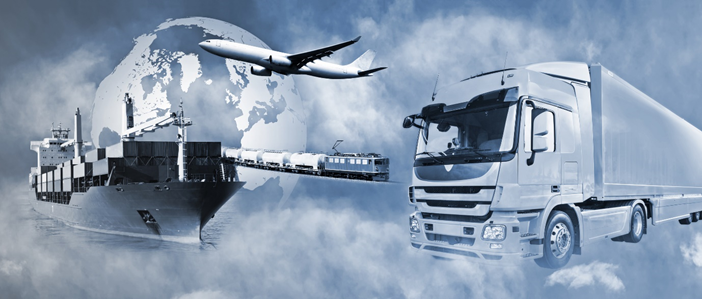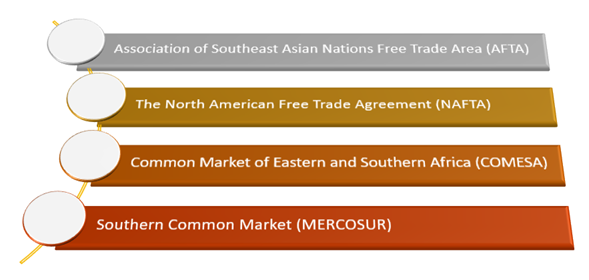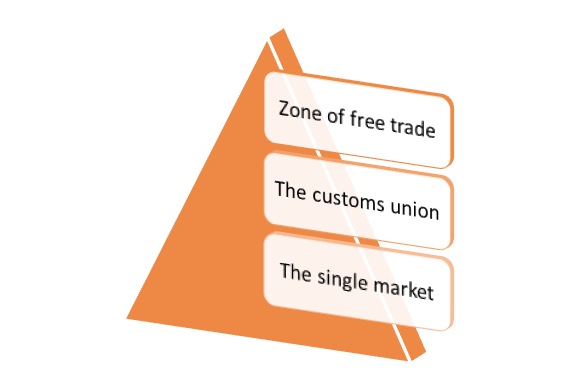What is free trade area?
A group of countries that agree to remove tariffs and other import bans on each other's goods in exchange for each participating country applying its tariff schedule to imports from non-member nations.
Free trade zones foster global trade and the associated benefits and the international division of specialisation and labour.
On the other hand, Free trade zones have been chastised for both the expenses of expanding economic integration and for arbitrarily restricting free trade.
Highlights
- A free trade area is a group of countries that have agreed to eliminate or reduce trade barriers.
- Free trade zones have been condemned for both the costs of developing economic integration and the arbitrariness with which they restrict free commerce.
- A free trade zone encourages competitiveness, which increases a country's productivity to stay competitive.
Frequently Asked Questions (FAQs)
What are the most significant free trade zones across the world?

Source: © Ironjohn | Megapixl.com
Association of Southeast Asian Nations Free Trade Area (AFTA)
The AFTA was inked in Singapore in January 1992. Thailand, Indonesia, Brunei, the Philippines, Malaysia, and Singapore were the founding members. Cambodia, Vietnam, Myanmar, and Laos are the four countries that have joined later.
The bloc has virtually eliminated all import and export tariffs on goods traded between the countries. It has also reached agreements with several other countries, notably China, to remove taxes on almost 90% of imported goods.
The North American Free Trade Agreement (NAFTA)
Mexico, the United States, and Canada have had free trade agreements in place since January 1994. Although tariffs were not eliminated until 2008, the total trilateral merchandise trade exceeded US$ 1.12 trillion in 2014.
According to the US government, business with Mexico and Canada provides over 140,000 small and medium-sized enterprises in the US and over three million jobs. In Canada, job growth has been even faster, with 4.7 million new employments generated since 1993. It is also the leading exporter of goods to the United States.
Common Market of Eastern and Southern Africa (COMESA)
COMESA, founded in December 1994, intends to develop human and natural resources to benefit the region's population. According to the United Nations, the primary goal is to create a vast economic and political entity to conquer trade restrictions.
The organisation is a significant marketplace, both inside Africa and abroad, with 19 member states and an annual export bill in addition to $80 billion.
COMESA's goal is to eliminate barriers to intra-regional trade, beginning with preferential tariffs and progressing toward a tariff-free common market and economic union.
Southern Common Market (MERCOSUR)
MERCOSUR was envisioned as a Latin American single market that would allow free movement of products, people, services, and capitals, but that vision has yet to materialise. Instead, internal turmoil has impeded progress toward the free movement of products and people, as well as the elimination of tariffs.
However, MERCOSUR remains one of the world's most powerful economic blocs, significantly impacting the global economy and South American trade.

Source: Copyright © 2021 Kalkine Media
What is the meaning of a free trade agreement?
When two or more countries comply with the terms of their trade, this is known as a free trade agreement. They are in charge of determining the duties and tariffs that countries levy on exports and imports. Thus, all trade agreements have an impact on global trade.
Moreover, the Trans-Pacific Partnership (TPP) is on track to become the world's largest trade deal once wholly ratified. The TPP already encompasses 40% of global GDP, and commerce between member countries is substantial.
On the other hand, the deal aims to increase economic growth and strengthen financial connections by reducing tariffs and other trade barriers.
The Transatlantic Trade and Investment Partnership (TTIP) is a pact that the United States and the European Union actively negotiate. It would become the world's largest trade deal if it were to be reached, covering 45% of global GDP. It, like the TPP, intends to reduce import tariffs and regulatory hurdles.
What is the distinction between an FTA, a customs union, and a single market?
Zone of free trade
A free trade area aims to eliminate laws and taxes that apply to member countries that trade. Instead, members agree on a set of policies governing trade conditions, quotas, and tariffs.
Another feature of a free trade area is that imports outside the zone do not qualify for the agreement's benefits.
The customs union
A customs union, like an FTA, lowers taxes among its participants and establishes a standard external tariff on exported and imported goods for non-members. The fundamental distinction between an FTA and a customs union is that an FTA transaction requires higher compliance.
The single market
Because it fosters frictionless trade, a single market is more comprehensive than a customs union. Any member understands that every product produced by the group's members is suitable for all members' distribution, sale, and usage.
A single market, in essence, offers a fair playing field for all members, encompassing not only marketable goods and services but also allowing individuals of any member country to work within the region freely.

Source: Copyright © 2021 Kalkine Media
What are the benefits of establishing a free trade area?
- A free trade zone promotes competitiveness, boosting a nation's productivity to keep up with its competitors. As a result, services and goods become of higher quality at a reduced cost.
- When there is fierce rivalry, countries will tend to manufacture the most efficient commodities or products, which maximises profit.
- Monopolies are also removed because more players can enter and join the market when free trade and tariffs and quotas are gone.
- When competition is especially worldwide, prices will almost always fall, giving customers more buying power.
- Imports are getting more affordable, giving customers access to a broader range of low-cost products.
What are the drawbacks of a free trade zone?
- Domestic producers can often replicate the products and sell them as knockoffs without fear of legal ramifications when imports are free to trade.
- With a free trade area, outsourcing work to more impoverished countries could become a norm. Workers may be compelled to work in poor and unhealthy work surroundings since many countries lack labour protection regulations.
- Because member countries are no longer subject to import taxes, they must devise strategies to make up for the lost revenue.
 Please wait processing your request...
Please wait processing your request...